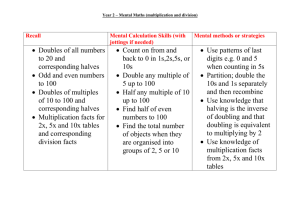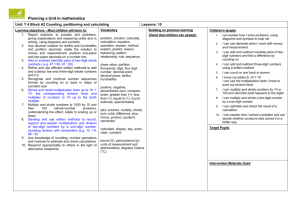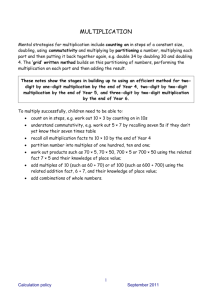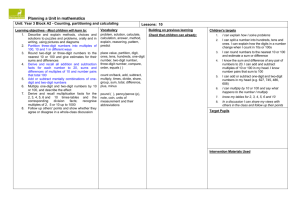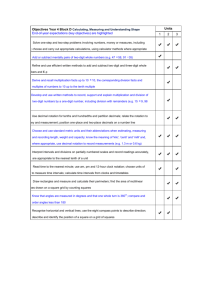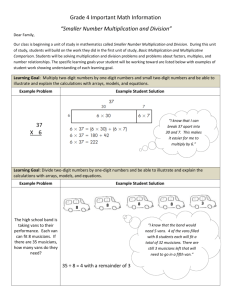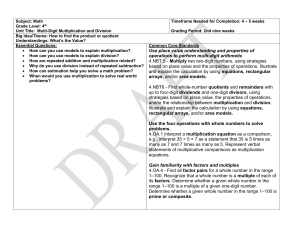Multiplication and Division
advertisement
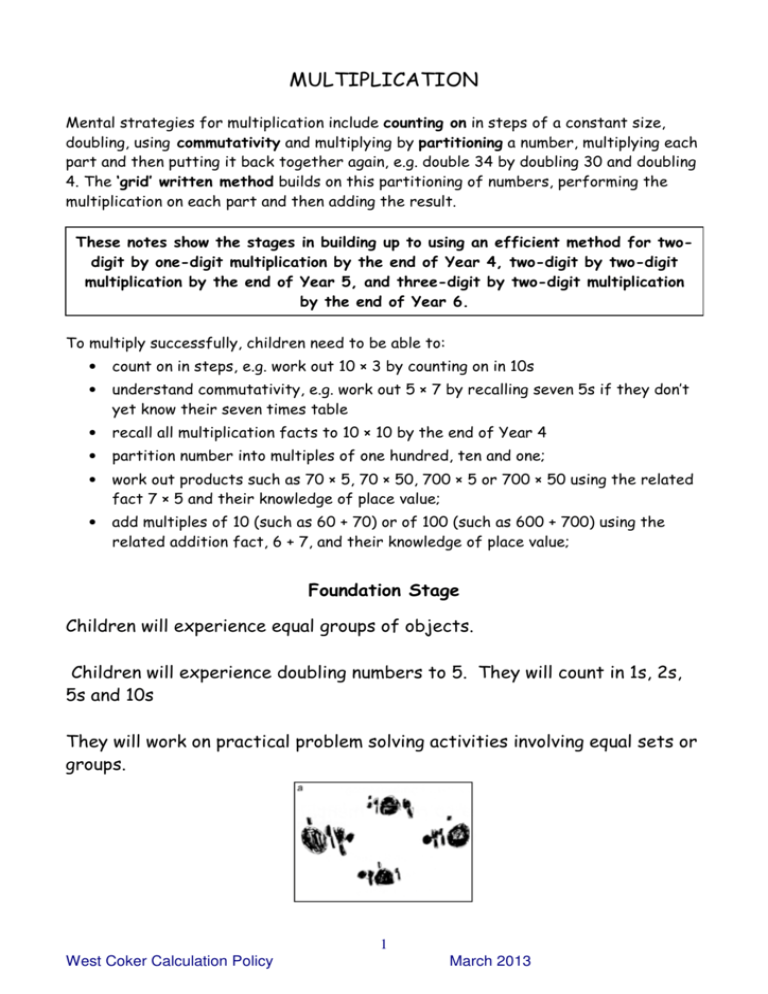
MULTIPLICATION Mental strategies for multiplication include counting on in steps of a constant size, doubling, using commutativity and multiplying by partitioning a number, multiplying each part and then putting it back together again, e.g. double 34 by doubling 30 and doubling 4. The ‘grid’ written method builds on this partitioning of numbers, performing the multiplication on each part and then adding the result. These notes show the stages in building up to using an efficient method for twodigit by one-digit multiplication by the end of Year 4, two-digit by two-digit multiplication by the end of Year 5, and three-digit by two-digit multiplication by the end of Year 6. To multiply successfully, children need to be able to: • count on in steps, e.g. work out 10 × 3 by counting on in 10s • understand commutativity, e.g. work out 5 × 7 by recalling seven 5s if they don’t yet know their seven times table • recall all multiplication facts to 10 × 10 by the end of Year 4 • partition number into multiples of one hundred, ten and one; • work out products such as 70 × 5, 70 × 50, 700 × 5 or 700 × 50 using the related fact 7 × 5 and their knowledge of place value; • add multiples of 10 (such as 60 + 70) or of 100 (such as 600 + 700) using the related addition fact, 6 + 7, and their knowledge of place value; Foundation Stage Children will experience equal groups of objects. Children will experience doubling numbers to 5. They will count in 1s, 2s, 5s and 10s They will work on practical problem solving activities involving equal sets or groups. 1 West Coker Calculation Policy March 2013 Year 1 (Level 1b/1a) Double single-digit numbers to 10 Double 5 Count on in steps 1 2 3 4 5 2, 4, 6, 8, 10… 2, Double 6, two groups of 6 10 10, 4, + 20, 30, Count on in repeated steps Find five 3s, six 5s, five 10s Use commutativity Know that 5 × 3 can be worked out as three 5s or five 3s Double 23 is double 20 plus double 3, 40 + 6 = 46 3×5 = 5×3 Double two-digit numbers 2 West Coker Calculation Policy 6, 10 Year 2 (Level 2b/2a) March 2013 6 7 8 8, + 9 10… 10 40, 50… 10 Year 3 (Level 2a/3c) Double two-digit numbers -Double 46 46 40 6 80 12 92 Year 4 (Level 3b) Main Focus Grid method Multiply any two-digit numbers by singledigit numbers 93 x 8 = 744 Multiply teens numbers by single-digit numbers 17 × 3 = 10 x 3 =30 and 7 x 3 = 21 30+21=51 x 10 7 3 30 21 Multiply three-digit numbers by singledigit numbers and two-digit numbers two-digit numbers x 200 50 6 3 600 150 18 30 600 180 2 40 12 8 720 24 =744 Multiply four-digit numbers by singledigit numbers and three-digit numbers two-digit numbers 256 x 23 = 5888 =768 26 x 32 = 832 6 3 Year 6(Level 4b/4a) 256 x 3 = 768 20 90 =51 Year 5 (Level 3a/4c) x x 600 180 40 12 832 x 200 20 4000 3 600 50 1000 120 150 18 Moving to long multiplication for children who possibly struggle with layout of grid method. 3 West Coker Calculation Policy 6 4000 1000 120 600 150 18 5888 March 2013 DIVISION Children consider division as sharing (halving and quartering) and division as grouping (how many groups in…?). The written method used for division is based on the ‘grouping’ method of division and is known as ‘chunking’. These notes show the stages in building up to using an efficient method for twodigit by one-digit division by the end of Year 4, three-digit by one-digit division by the end of Year 5, and three-digit by two-digit division by the end of Year 6. To divide successfully, children need to be able to: • count on in steps, e.g. work out 18 ÷ 3 by counting on in 3s • understand and use multiplication and division as inverse operations; • partition two-digit and three-digit numbers in different ways, e.g. partition 42 into 30 and 12 when dividing by 3 (dividing 30 by 3 and 12 by 3); • recall multiplication and division facts to 10 × 10, recognise multiples of one-digit numbers and multiply multiples of 10 or 100 by a single-digit number using their knowledge of multiplication facts and place value; • understand that division can leave a remainder; • understand that division by grouping and sharing (halving/quartering) give the same answer and choose which is most efficient for a given calculation • use multiplication facts and place value to estimate how many times one number divides into another – for example, how many sixes there are in 147, or how many 23s there are in 472; Foundation Stage Children will understand equal groups and share items out in play and problem solving. They will count in 1s, 2s and 10s. 4 West Coker Calculation Policy March 2013 Year 1 (Level 1b/1a) Halving by Sharing Find half of 8, by sharing 8 cubes between two people or folding a strip of 8 objects in half. Begin to find a quarter by halving and halving again, e.g. find a quarter of 8. Year 2 (Level 2b/2a) Halving and quartering Find half and a quarter of 20. Grouping 18 ÷ 3, how many groups of 3 are in 18? 0 1 2 3 4 5 6 7 8 9 10 11 12 13 14 15 16 17 18 188 Use multiplication facts to help, e.g. 60 ÷ 10: how many 10s are in 60? 20 ÷ 5: how many 5s are in 20? Realise that division can sometimes leave some ’left over’ 16 ÷ 3 5 West Coker Calculation Policy March 2013 Year 3 (Level 2a/3c) Year 4 (Level 3b) Chunking Taking off a chunk of the divisor using a multiple of 10: 67 ÷ 3, 100 ÷ 6 Horizontal chunking on an empty number line Key Facts: 2 x 6 = 12, 5 x 6 = 30 and 10 x 6 = 60 Introduce the key: 2 x 5 x 10 x 100 ÷ 6 100 - Dividing giving answers just over 10 42 ÷ 3: x10 x4 60 (X10) 40 - 36 (X6) 4 = 16 Year 5 (Level 3a/4c) Year 6 (Level 4b/4a) Chunking Chunking – 3 digit divided by 2 digit eg long division Using knowledge of multiplication facts and place value to use chunk efficiently 556 ÷ 25 Key Facts 2 x 6 =12 and 5 x 6 = 30 × 10 = 60 × 20 = 120 × 30 = 180 × 40 = 240 The answer is between 30 and 40, so I’ll subtract 30 lots of 6, leaving 16. Key Facts × 10 = 250 × 20 = 500 196 ÷ 6 196 - 180 (X30) 556 16 - 12 25 ÷ (X2) 556 4 = 32 500 (X20) 56 196 ÷ 6 = 32 r 4 - 50 (X2) 6 =22 = Short division or decimal answers and money division 6 West Coker Calculation Policy March 2013


